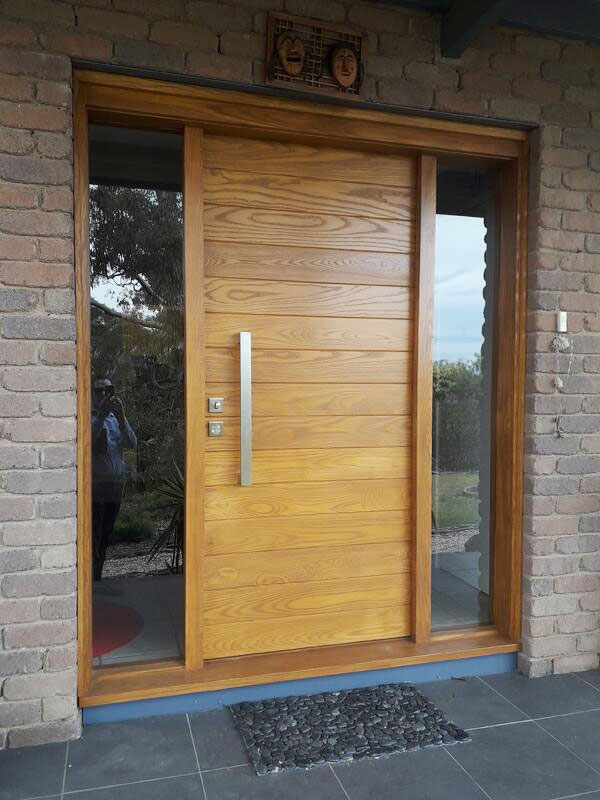DOES YOUR FRONT DOOR GET DRAFTY IN THE WINTER?
Before colder weather sets in, you may want to investigate if your door has a draft and fix the issue, so it does not affect the warmth of your home. Keep reading to discover why doors become draughty and solutions on how the problem can be solved.
Renovate your Entrance way with this tool [Free Excel Template]
Solid timber front doors have been a tradition for as long as we can remember. There is something satisfying and even comforting about solid hardwood between your home and the outside world. Wood doors are less likely to dent compared to metal doors or shatter like glass. Though it’s rare these days, we even imagine that we can smell the wood underneath layers of paint or varnish and sealant. But not all wooden doors are the same. The thing about solid timber doors is that they are made of natural material, material that can be of higher or lower quality, ages, changes with the seasons, and can even change in size depending on the climate outside.
There are a lot of things people don’t know about wood front doors. Like why they sometimes stick and sometimes open smoothly, why some withstand the test of time better than others, and why some wood doors seem to let the winter cold in while others do not. Especially in winter, many people may be wondering why their solid timber door, which fit so well in the frame in the warmer months, is suddenly a source of drafts just as it’s getting chilly outside, and as your front door experts, today we’re eager to give you a complete explanation along with several possible solutions to your draughty front door problem.

Why Timber Doors Swell and Shrink
The first thing to understand about timber doors is that because they are made of wood, they are not always the same size or perfect shape as the day they were cut. Even if your door was installed perfectly, sanded down to fit the frame and re-sealed around the edges, it will not always fit the same way in your door frame. While it’s hard to see in most other wood items, wood responds in subtle ways to temperature and humidity.
When the humidity is high, especially combined with warm temperatures, the actual plant-cells in the wood fibre swell with water like they did when the door was part of a living tree. This causes your door to increase in size, which is why your door may stick in the frame when it rains or becomes notably humid outside. However, the opposite is also true.
Doors can also shrink in dry and very cold weather. Just like how living trees go dormant and sometimes seem to ‘shrivel’ in cold winters, your timber door does the same. When it gets dry and cold, the cells will not hold water the way they do when it’s humid and the door will shrink in the frame. This can cause gaps around the edge of the door, creating an opportunity for drafts.
Why High-Quality Timber Fit Better in the Frame
One of the reasons wood front doors can seem so unpredictable is because quality matters a great deal in creating a secure solid timber front door. The type of wood, the way it is cut and cured, and how well it is fitted into the door frame are all factors in how the door performs. Low-quality timber doors, and many older doors made with less sophisticated techniques, are more likely to swell, shrink, causing them to fit poorly in their frames.
Modern high-quality timber doors, on the other hand, are made in a way that reduces weather-based response. From timber selection to how you seal them, a new timber front door is less likely to cause seasonal trouble than older doors or doors of lower quality.

Weather-Stripping Does the Rest
Weather stripping is important for any type of door because it provides a weather-proof seal between the door and the frame. But it’s especially important for timber doors because of the size changing factor we’ve been discussing. Weather stripping allows you to have a door that doesn’t stick when it swells, and no cold drafts when it shrinks.
You should also consider having an additional seal at the bottom of the door. A drop seal is a popular choice as it automatically lifts when the door is opened to ensure smooth movement and drops when the door is closed to prevent drafts.
If you choose to replace your draughty old timber door with a new high-quality solid timber door, weather stripping is the answer to the small amount of swelling and shrinking that is inevitable.

Modern Alternatives to Timber Doors
Of course, with modern technology also comes modern alternatives. Humans have relied on solid timber doors for centuries because before advanced material developments, timber was the most secure and weather-proof material we had to make doors out of. But today’s front door selection goes so far above and beyond traditional timber.
Aluminium doors, for example, are no longer the easily dented and highly temperature-conductive doors they used to be. With insulation and design advancements, you could replace your old wooden door with a sleek aluminium door. This is a great way to provide your home with security and style with the use of a modern material door.
But even more impressive than aluminium is composite fibreglass. Made entirely of advanced constructed materials, composite doors are undentable, immune to the elements, and layered with insulation and reinforcement. They are the peak of modern comfort, security, and convenience in front door technology.
Renovate your Entrance: Checklist, Budget, and Timeline Planner [Free Excel Template]
If your current front door sticks in the summer and is draughty in the cold winters, it may be time for a change. Here at Parkwood, we know that choosing a new front door can be a very personal decision which is why we offer a wide selection of materials and styles. Whether you want the traditional solid timber front door, the modern style of aluminium, or the advanced technology of a composite entryway, we can help you find the perfect new front door for your home. Summer and winter, the right front door will swing smoothly in the frame and ensure your home is safe from whatever the weather might be outside. For more information about how to choose a front door that won’t stick or become a source of cold winter drafts, contact us today!


